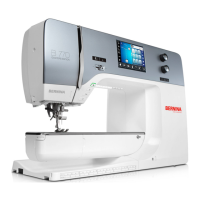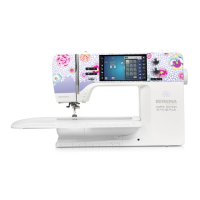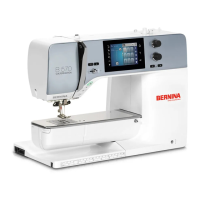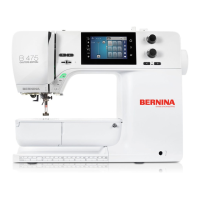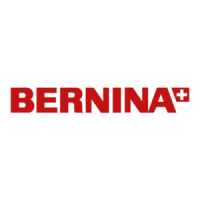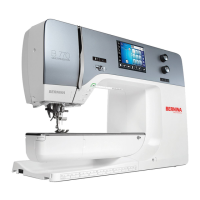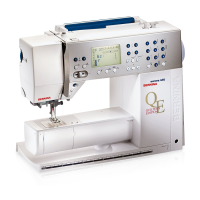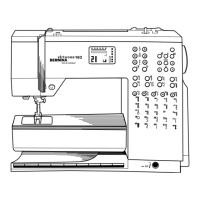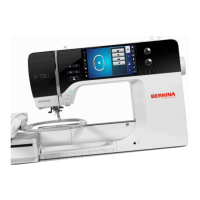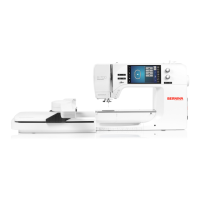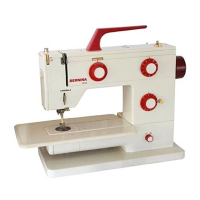Do you have a question about the Bernina 750 QE and is the answer not in the manual?
Introductory letter from the owner.
Basic safety precautions and warnings for electrical appliance use.
Critical warnings regarding electrical shock risks.
Warnings about burns, fire, electric shock, or injury.
BERNINA's commitment to minimizing environmental impact.
Guidelines for servicing double-insulated sewing computers.
Limitation of liability for misuse of the sewing computer.
Explanation of warning symbols and indicators used in the manual.
Definitions of technical terms and abbreviations used in the manual.
Listing and identification of included standard accessories for the sewing computer.
Visual guide and identification of various presser feet for different sewing applications.
Details on the accessory box storage and proper handling of bobbins.
Identification of external parts and controls of the sewing computer.
Close-up view of specific parts and their functions on the sewing computer.
Guidance on choosing appropriate thread types and their properties for sewing.
Advice on selecting correct needles based on thread and fabric types for optimal results.
Guidance on selecting correct needle and thread combinations for optimal results.
Detailed information and types of sewing needles suitable for various materials and techniques.
Instructions on connecting power, using the power switch, and the foot control.
Guidance on using the slide-on table and winding bobbins.
Instructions for operating the presser foot lifter and using the vertical spool pin.
Step-by-step procedures for winding bobbins and inserting them correctly.
Instructions for threading the upper thread and changing the sewing needle.
Procedures for threading the machine with double and triple needles.
Detailed steps for threading the sewing machine needle and handling presser feet.
How to remove and replace the stitch plate for different sewing operations.
How to alter tension and adjust presser foot pressure for different fabrics.
Explanation of feed dog function and how to lower or raise it for different sewing tasks.
Explanation of the main function buttons and their uses during sewing operations.
Explanation of stitch width/length knobs and needle position buttons.
Overview of the main display interface, system settings, and menu selections.
How to select stitch patterns and view their details on the display.
Explanation of general sewing functions and their icons.
Explanation of 'Information', 'Back', and 'Confirm selection' controls.
Detailed controls for functions like needle stop, pattern begin, securing, and pattern repeat.
Adjusting stitch density and controlling needle position.
Using mirror image features and saving patterns in personal memory.
Using security programs and managing default settings.
Adjusting buttonhole slit width, balance, and thread tension.
Understanding presser foot indicators and adjusting pressure.
Managing securing, pattern repeat, and length for alphabet stitches.
Adjusting mirror image, needle position, and security program settings.
Overview of functions available within the Combi mode for stitch combinations.
Editing, subdividing, and interrupting stitch combinations.
Using combination subdividers and securing functions within stitch combinations.
Deleting stitch patterns and mirroring entire combinations.
Introduction to the setup program for customizing machine settings and display.
How to change display brightness, sewing light, and welcome text.
Configuration options for sewing speed, thread tension, and securing stitches.
Procedures for calibrating embroidery hoops and adjusting audio signals.
Instructions for updating software and managing user data, including reset options.
Instructions for calibrating the buttonhole foot and cleaning the thread catcher.
Procedures for resetting settings and deleting user data.
Accessing system information, version details, and language settings.
Accessing dealer details and saving service data.
Step-by-step visual guidance for various sewing techniques and troubleshooting.
Assistance with sewing techniques, suggesting needles, and presser feet based on fabric.
Accessing information and recommendations for stitch patterns and functions.
How to correct stitch formation by adjusting balance for different fabrics and materials.
How to activate and deactivate the energy-saving eco mode.
Visual catalog and descriptions of available practical stitches for various sewing needs.
Guide on how to select stitch patterns by category or number for sewing.
Methods for temporarily altering and permanently saving stitch pattern modifications.
Demonstrations and applications of specific practical stitches like straight stitch and zipper.
Presentation of various buttonhole styles and their applications.
Key guidance on marking lengths, test sewing, and adjusting buttonhole parameters.
Techniques for using cords for reinforcement and stabilizers for improved stitch quality.
How to adjust stitch balance and program automatic buttonholes with various features.
Introduction to decorative stitches, categories, and their use on different materials.
Demonstrations of cross stitches, pintucks, and bobbin-play sewing techniques.
Catalog of stitch patterns specifically designed for quilting, patchwork, and appliqué.
Guidance on performing free-motion quilting and darning using specific feet and settings.
Explanation of the BSR function for consistent stitch length in free-motion sewing.
Detailed instructions on using BSR modes, needle stop, and securing functions.
How to attach, engage, and disengage the BERNINA Dual Feed for even fabric feeding.
Information on presser feet compatible with the BERNINA Dual Feed system.
Step-by-step instructions for engaging and disengaging the Dual Feed.
Advice on working with difficult fabrics using the Dual Feed system.
Introduction to available alphabets and their character sets for lettering.
Steps for combining letters, inserting, deleting, and correcting text for personalization.
Using alphabets in combination with functions like changing size and selecting cases.
How to save custom stitch patterns and alterations in the personal program.
Guide to creating, saving, editing, and deleting stitch combinations.
Instructions for connecting the embroidery module to the sewing computer.
Guidance on selecting and attaching the correct embroidery foot and needle.
Procedures for using embroidery hoops, templates, and hooping materials correctly.
Information on different types of stabilizers and their application for embroidery.
How to enter and navigate between embroidery, sewing, and selection menus.
Tools and functions for editing motifs, including moving, zooming, mirroring, and rotating.
Selecting, entering lettering, correcting, and deleting embroidery alphabets and motifs.
Using functions like move, enlarge, rotate, and mirror for combining embroidery motifs.
Procedures for saving motifs to computer memory or USB stick and overwriting existing ones.
Steps for selecting hoops and starting the embroidery process.
Using the embroidery menu, start/stop button, and foot control for embroidery operations.
Troubleshooting steps for upper/lower thread breaks and sequence control.
Instructions for cleaning the display, feed dog area, and hook assembly.
Proper procedure for lubricating the sewing computer's internal parts.
Common faults like uneven stitches, skipped stitches, and motor problems with repair steps.
Solutions for needle breaks, display issues, thread indicators, and update errors.
Troubleshooting steps for hoop issues, motif placement, and process interruptions.
Guidance on cleaning, lubrication, and contacting service for maintenance alerts.
Visual catalog and descriptions of available practical stitches for various sewing needs.
Visual catalog of different buttonhole styles and their corresponding stitch numbers.
Introduction to decorative stitches, categories, and their use on different materials.
Visual representation of Block and Double-Block alphabet stitches.
Collection of decorative embellishment motifs with dimensions.
Assortment of quilting-specific embroidery motifs with dimensions.
Collection of border and lace embroidery motifs with dimensions.
Embroidery motifs themed around children's designs with dimensions.
Embroidery motifs themed around seasonal designs with dimensions.
Embroidery motifs themed around sports and hobbies with dimensions.
Collection of animal-themed embroidery motifs with dimensions.
Collection of floral embroidery motifs with dimensions.
Visual examples of different alphabet styles available for lettering.
Information about the manual's creation, including text, graphics, and copyright details.
Introductory letter from the owner.
Basic safety precautions and warnings for electrical appliance use.
Critical warnings regarding electrical shock risks.
Warnings about burns, fire, electric shock, or injury.
BERNINA's commitment to minimizing environmental impact.
Guidelines for servicing double-insulated sewing computers.
Limitation of liability for misuse of the sewing computer.
Explanation of warning symbols and indicators used in the manual.
Definitions of technical terms and abbreviations used in the manual.
Listing and identification of included standard accessories for the sewing computer.
Visual guide and identification of various presser feet for different sewing applications.
Details on the accessory box storage and proper handling of bobbins.
Identification of external parts and controls of the sewing computer.
Close-up view of specific parts and their functions on the sewing computer.
Guidance on choosing appropriate thread types and their properties for sewing.
Advice on selecting correct needles based on thread and fabric types for optimal results.
Guidance on selecting correct needle and thread combinations for optimal results.
Detailed information and types of sewing needles suitable for various materials and techniques.
Instructions on connecting power, using the power switch, and the foot control.
Guidance on using the slide-on table and winding bobbins.
Instructions for operating the presser foot lifter and using the vertical spool pin.
Step-by-step procedures for winding bobbins and inserting them correctly.
Instructions for threading the upper thread and changing the sewing needle.
Procedures for threading the machine with double and triple needles.
Detailed steps for threading the sewing machine needle and handling presser feet.
How to remove and replace the stitch plate for different sewing operations.
How to alter tension and adjust presser foot pressure for different fabrics.
Explanation of feed dog function and how to lower or raise it for different sewing tasks.
Explanation of the main function buttons and their uses during sewing operations.
Explanation of stitch width/length knobs and needle position buttons.
Overview of the main display interface, system settings, and menu selections.
How to select stitch patterns and view their details on the display.
Explanation of general sewing functions and their icons.
Explanation of 'Information', 'Back', and 'Confirm selection' controls.
Detailed controls for functions like needle stop, pattern begin, securing, and pattern repeat.
Adjusting stitch density and controlling needle position.
Using mirror image features and saving patterns in personal memory.
Using security programs and managing default settings.
Adjusting buttonhole slit width, balance, and thread tension.
Understanding presser foot indicators and adjusting pressure.
Managing securing, pattern repeat, and length for alphabet stitches.
Adjusting mirror image, needle position, and security program settings.
Overview of functions available within the Combi mode for stitch combinations.
Editing, subdividing, and interrupting stitch combinations.
Using combination subdividers and securing functions within stitch combinations.
Deleting stitch patterns and mirroring entire combinations.
Introduction to the setup program for customizing machine settings and display.
How to change display brightness, sewing light, and welcome text.
Configuration options for sewing speed, thread tension, and securing stitches.
Procedures for calibrating embroidery hoops and adjusting audio signals.
Instructions for updating software and managing user data, including reset options.
Instructions for calibrating the buttonhole foot and cleaning the thread catcher.
Procedures for resetting settings and deleting user data.
Accessing system information, version details, and language settings.
Accessing dealer details and saving service data.
Step-by-step visual guidance for various sewing techniques and troubleshooting.
Assistance with sewing techniques, suggesting needles, and presser feet based on fabric.
Accessing information and recommendations for stitch patterns and functions.
How to correct stitch formation by adjusting balance for different fabrics and materials.
How to activate and deactivate the energy-saving eco mode.
Visual catalog and descriptions of available practical stitches for various sewing needs.
Guide on how to select stitch patterns by category or number for sewing.
Methods for temporarily altering and permanently saving stitch pattern modifications.
Demonstrations and applications of specific practical stitches like straight stitch and zipper.
Presentation of various buttonhole styles and their applications.
Key guidance on marking lengths, test sewing, and adjusting buttonhole parameters.
Techniques for using cords for reinforcement and stabilizers for improved stitch quality.
How to adjust stitch balance and program automatic buttonholes with various features.
Introduction to decorative stitches, categories, and their use on different materials.
Demonstrations of cross stitches, pintucks, and bobbin-play sewing techniques.
Catalog of stitch patterns specifically designed for quilting, patchwork, and appliqué.
Guidance on performing free-motion quilting and darning using specific feet and settings.
Explanation of the BSR function for consistent stitch length in free-motion sewing.
Detailed instructions on using BSR modes, needle stop, and securing functions.
How to attach, engage, and disengage the BERNINA Dual Feed for even fabric feeding.
Information on presser feet compatible with the BERNINA Dual Feed system.
Step-by-step instructions for engaging and disengaging the Dual Feed.
Advice on working with difficult fabrics using the Dual Feed system.
Introduction to available alphabets and their character sets for lettering.
Steps for combining letters, inserting, deleting, and correcting text for personalization.
Using alphabets in combination with functions like changing size and selecting cases.
How to save custom stitch patterns and alterations in the personal program.
Guide to creating, saving, editing, and deleting stitch combinations.
Instructions for connecting the embroidery module to the sewing computer.
Guidance on selecting and attaching the correct embroidery foot and needle.
Procedures for using embroidery hoops, templates, and hooping materials correctly.
Information on different types of stabilizers and their application for embroidery.
How to enter and navigate between embroidery, sewing, and selection menus.
Tools and functions for editing motifs, including moving, zooming, mirroring, and rotating.
Selecting, entering lettering, correcting, and deleting embroidery alphabets and motifs.
Using functions like move, enlarge, rotate, and mirror for combining embroidery motifs.
Procedures for saving motifs to computer memory or USB stick and overwriting existing ones.
Steps for selecting hoops and starting the embroidery process.
Using the embroidery menu, start/stop button, and foot control for embroidery operations.
Troubleshooting steps for upper/lower thread breaks and sequence control.
Instructions for cleaning the display, feed dog area, and hook assembly.
Proper procedure for lubricating the sewing computer's internal parts.
Common faults like uneven stitches, skipped stitches, and motor problems with repair steps.
Solutions for needle breaks, display issues, thread indicators, and update errors.
Troubleshooting steps for hoop issues, motif placement, and process interruptions.
Guidance on cleaning, lubrication, and contacting service for maintenance alerts.
Visual catalog and descriptions of available practical stitches for various sewing needs.
Visual catalog of different buttonhole styles and their corresponding stitch numbers.
Introduction to decorative stitches, categories, and their use on different materials.
Visual representation of Block and Double-Block alphabet stitches.
Collection of decorative embellishment motifs with dimensions.
Assortment of quilting-specific embroidery motifs with dimensions.
Collection of border and lace embroidery motifs with dimensions.
Embroidery motifs themed around children's designs with dimensions.
Embroidery motifs themed around seasonal designs with dimensions.
Embroidery motifs themed around sports and hobbies with dimensions.
Collection of animal-themed embroidery motifs with dimensions.
Collection of floral embroidery motifs with dimensions.
Visual examples of different alphabet styles available for lettering.
Information about the manual's creation, including text, graphics, and copyright details.
| Stitch Width | 9 mm |
|---|---|
| USB Interface | Yes |
| Color Touch Screen | Yes |
| Memory | Yes |
| Automatic Thread Cutter | Yes |
| Speed Control | Yes |
| LCD Screen | Yes |
| USB Port | Yes |
| Built-in Memory | Yes |
| Sewing Speed | 1000 stitches per minute |
| BERNINA Stitch Regulator (BSR) | Yes |
